Raksha Bandhan
Raksha means protection and Bandhan means bond.
Raksha Bandhan or Rakhi festival is celebrated on Shravan Poornima, Narali Poornima, or Rakhi Poornima (full moon day of shravan month) which is usually in August month.
Rita-> Ritu-> Ritual
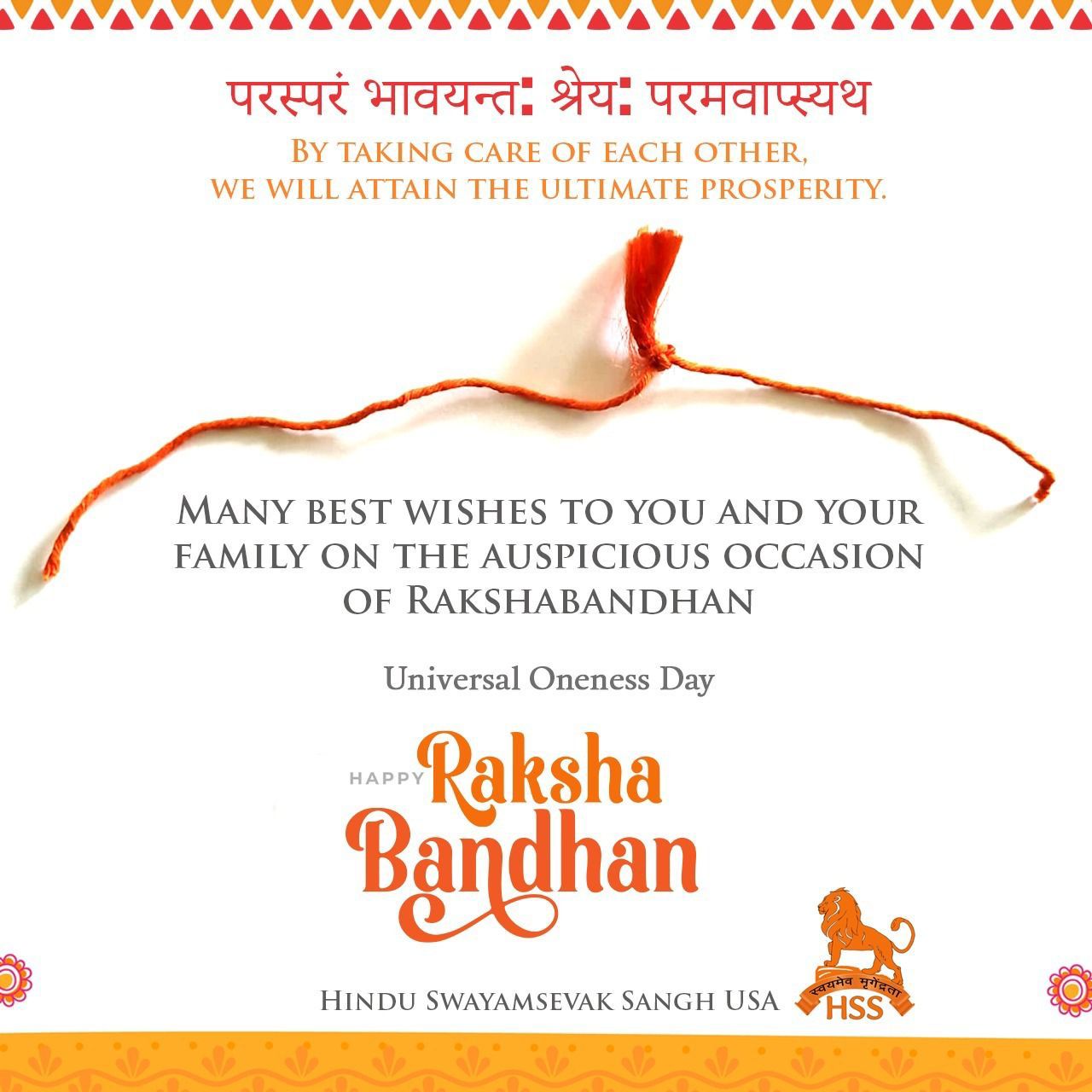
People tie a sacred thread ( Suraksha Kavach) on the wrist of others. It can be tied by anyone to anyone.
- Sister to brother
- Mother to son or daughter
- Child to mother
- Brother to brother
- Stranger to stranger
- People to flag e.g. swayam sewaks to Bhagwa Dhwaj
- Devotees to Devi/Devta
- Friend to friend
- Civilian to soldier
- Citizens to community leaders
If person A ties rakhi to person B, Person B takes pledge to protect person A emotionally/mentally, physically, and economically, even if it is at the cost of sacrifycing his own life.
The true secret of Raksha Bandhan is that when a sister ties the thread on her brother’s wrist, it is a gesture of saying that “i will protect you at all times”. So it is the sisters who pray and wish for the protection and well-being of their brothers. This is what Raksha Bandhan truly means. Women possess a very unique power within themselves – the Sankalpa-Shakti (the power of will and determination). So a woman too can protect and give support to a man using her strong will power and inner strength. Inner strength always trumps external one as the latter is nothing without the former. A Woman possess the power of feelings and emotions, and has great inner strength within them. So according to some philosophies, on the day of Raksha Bandhan, it is the women who protect the men with their blessings and inner strength (by tying a sacred thread on the wrist of the brother).
The central theme of this festival is mutual respect and a promise of standing by your loved ones while they grace you with their blessings and good wishes.
Some historically importance instances of tying Rakhi:
- Rakhi sent by Alexander's wife Roxane to Porus/Puru
- Chittor Rani Karnavati sent rakhi to Humayun--Women, in order to save themselves, sent rakhis to neighbouring kings after their husbands and brothers were killed by the cunning and unethical Islamic invaders. The most well-known tale is that of Rani Karnavati of Chittorgadh who sent a Rakhee to Humayun to protect her from Bahadur Shah of Gujarat.
- Laxmi tied rakhi to Bali
- Draupadi ties a piece of her saree to Krishn--In Mahabharat , Draupadi the wife of the Pandavas had once torn a strip of silk off her sari and tied it around krishna’s wrist to stop the bleeding from a battlefield wound. Krishn was touched by her gesture and declared her to be his sister, even though they were not related by blood. He promised to repay the debt and then spent the next 25 years doing just that.
- Rajpurohit to Yudhistir
- Indrani/Sachi to her husband Indr--Devi Shachi, in her role akin to adi shakti , tied the thread to dev Indra , gracing him with her strength, motivating him to fight the asurs who had repeatedly assaulted and defeated him and his devtas. Dev Indra had become despondent and weak and lost his will to fight back. However, after tying of the thread and shielded with powers of Shachi, Indra got motivated and once again fought the asurs and regained his kingdom of heaven.
- In 1905, gurudev Rrabindranath Thakur used the original symbolism of Raksha Bandhan to unite Bengalis (irrespective of whether they were Hindus or Muslims). This started the ritual of brothers tying Rakhee to brothers in order to protest against the partition of Bengal.
These stories make sense only if the person tying Rakhi needs protection. If the person who is receiving Rakhi gets protection, then these stories make no sense.
Why should we celebrate Rakshabandhan:
- To pay samajik rin
- For social/community security and harmony
- To build a great team
- To practically achieve Sarve Bhavantu Sukhina
There is no mention of the Raksha Bandhan festival in the scriptures. No rakhi celebrations in treta and dwapar yug. The only instance which is closely related to Raksha Bandhan is of Draupadi and Krishna. When Krishna's finger was hurt while firing Sudarshan chakra on Sishupal, Draupadi tore a piece of her saree and tied it on Krishna's finger.
Most likely, this festival came into existence later on. Old stories of Raksha Bandhan are not in the context of brother-sister but the context of queen and enemy or a victim and powerful person.
I heard from elders that in ancient times Pandit Ji / Panditayan Ji used to go to people's houses. They used to tie a sacred thread on the wrist of people. Pandit is believed to be a pure atma, and he has great knowledge. He was a symbol of purity and divinity. He was the right candidate to chant mantras and tie a sacred thread for the protection of people. Pandit was not into worldly things and was not earning any livelihood. So, people were giving him gifts/financial assistance. So, pandit was tying thread and praying for the protection of people and in turn, people were giving him things to survive. Later on, it took the form of females tying that thread to males. Nowadays, anyone can tie the sacred thread to anyone.
Tilak is placed on the forehead to remind us that it is the place of the third eye and atma.
Giving sweets to each other is a reminder for us to speak in a sweet voice.
Presently, many do not need financial assistance in exchange for tying sacred threads, so instead of giving gifts/money, we can give up our bad habits.
Festivals on Raksha bandhan day:
- Hayagriva jayanti
- Rig Ved Upakarna
- Yajur Ved Upakarma
- Gayatri Jayanti
8th day after Raksha bandhan is Janmastami or Krishn's birthday.
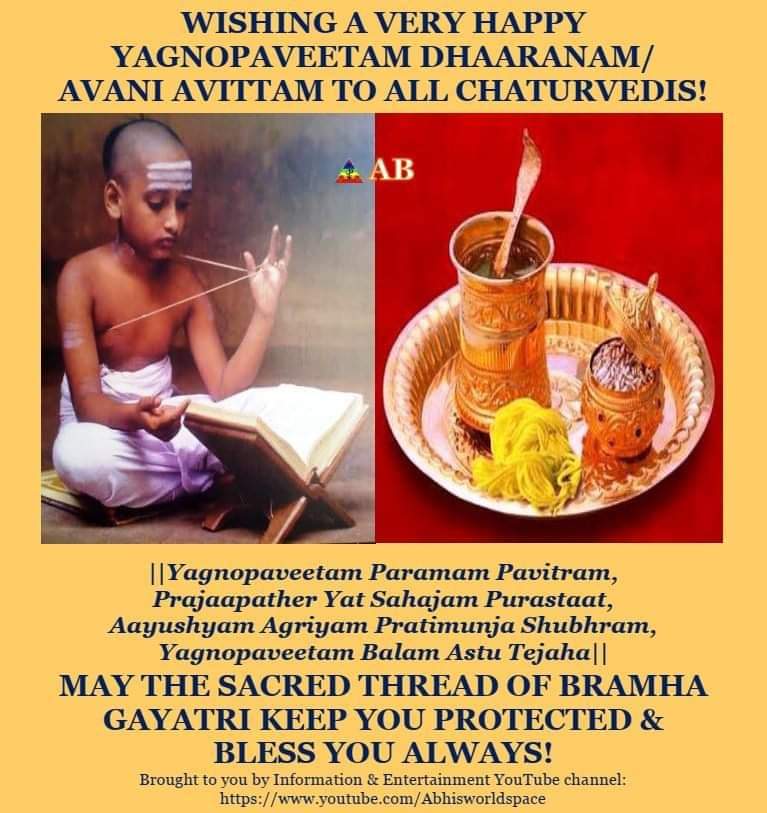
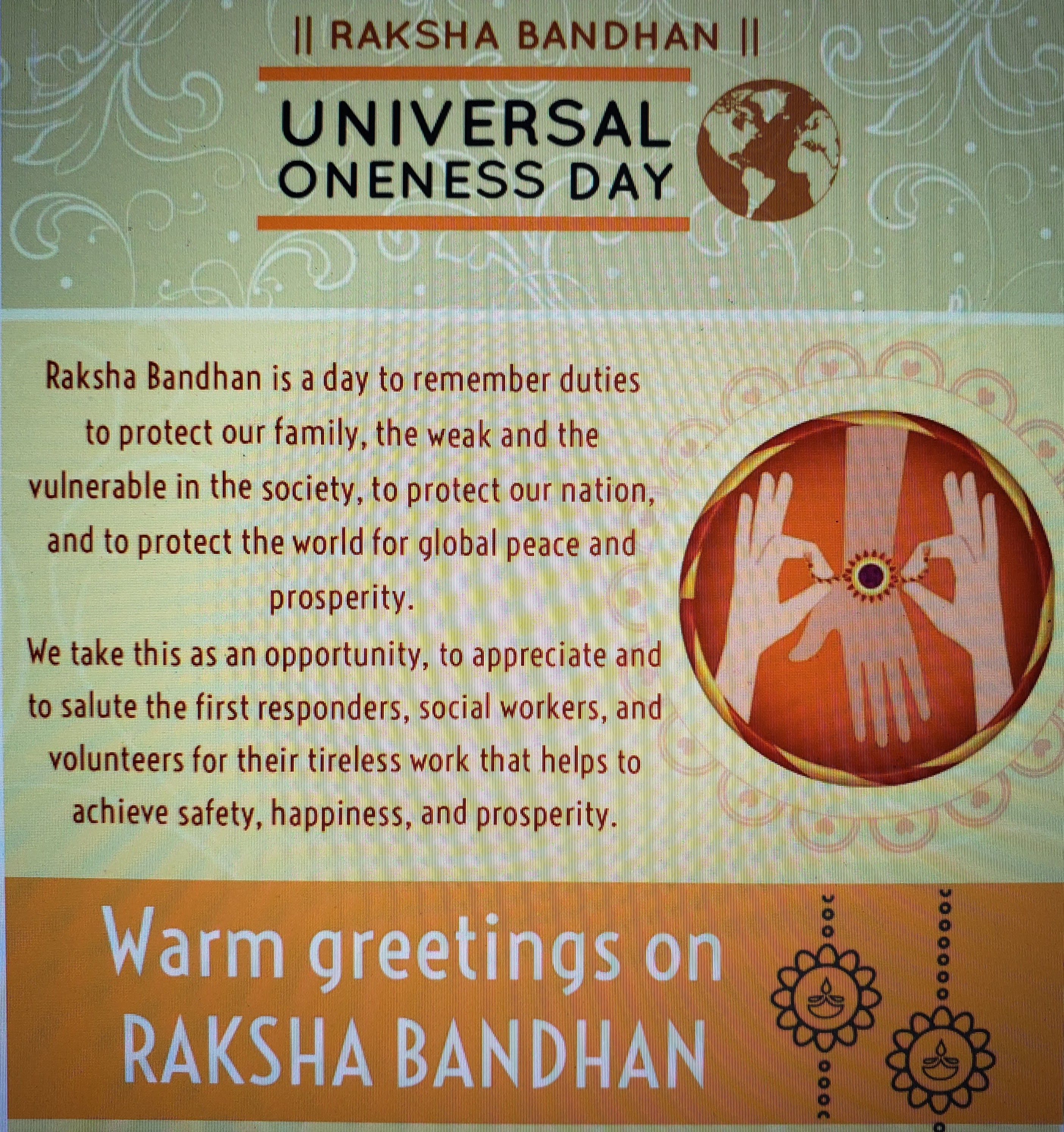
It is universal brotherhood day. On this day we reinforce our values to protect the weak and vulnerable, and minorities. India believes in universal oneness.
Azadi ka Amrit Mahotsav: Amrit Bandhan on Raksha Bandhan. Amrit Bandhan rakhis to be ties to people who are engaged in duty and devotion to the nation. Rakhis to be ties to jawans by girls in orphanages.
Bharti Raizada
रक्षाबंधन के नाम पर सेक्युलर घोटाला-
बचपन में हमें अपने पाठयक्रम में पढ़ाया जाता रहा है कि रक्षाबंधन के त्योहार पर बहने अपने भाई को राखी बांध कर उनकी लम्बी आयु की कामना करती है। रक्षा बंधन का सबसे प्रचलित उदहारण चित्तोड़ की रानी कर्णावती और मुगल बादशाह हुमायूँ का दिया जाता है।
कहा जाता है कि जब गुजरात के शासक बहादुर शाह ने चित्तोड़ पर हमला किया तब चित्तोड़ की रानी कर्णावती ने मुगल बादशाह हुमायूँ को पत्र लिख कर सहायता करने का निवेदन किया। पत्र के साथ रानी ने भाई समझ कर राखी भी भेजी थी। हुमायूँ रानी की रक्षा के लिए आया मगर तब तक देर हो चुकी थी। रानी ने जौहर कर आत्महत्या कर ली थी। इस इतिहास को हिन्दू-मुस्लिम एकता तोर पर पढ़ाया जाता हैं।
अब वास्तविकता जानिये और सेक्युलर घोटाले को जानिये-
हमारे देश का इतिहास सेक्युलर इतिहासकारों ने लिखा है। भारत के पहले शिक्षा मंत्री बहुत ही कम पढ़े लिखे मौलाना अब्दुल कलाम थे। जिन्हें साम्यवादी विचारधारा के पोषक और हिन्दू विचारधारा का अनन्य विरोधी नेहरू जी ने सख्त हिदायत देकर यह कहा था कि जो भी इतिहास पाठयक्रम में शामिल किया जाय, उस इतिहास में यह न पढ़ाया जाये कि मुस्लिम हमलावरों ने हिन्दू मंदिरों को तोड़ा, हिन्दुओं को जबरन धर्मान्तरित किया, उन पर कोई अत्याचार किये और मौलाना ने नेहरू जी की सलाह को मानते हुए न केवल सत्य को छुपाया अपितु उसे पूर्णतया विकृत भी कर दिया।
रानी कर्णावती और मुगल बादशाह हुमायूँ के किस्से के साथ भी यही अत्याचार हुआ। जब रानी को पता चला की बहादुर शाह उस पर हमला करने वाला है तो उसने हुमायूँ को पत्र तो लिखा।
मगर हुमायूँ को पत्र लिखे जाने का बहादुर खान को पता चल गया। बहादुर खान ने हुमायूँ को पत्र लिख कर इस्लाम की दुहाई दी और एक काफिर की सहायता करने से रोका।
मिरात-ए-सिकंदरी में गुजरात विषय से पृष्ठ संख्या 382 पर लिखा मिलता है-
सुल्तान के पत्र का हुमायूँ पर बुरा प्रभाव हुआ। वह आगरे से चित्तोड़ के लिए निकल गया था। अभी वह गवालियर ही पहुंचा था। उसे विचार आया, "सुलतान चित्तोड़ पर हमला करने जा रहा है। अगर मैंने चित्तोड़ की मदद की तो मैं एक प्रकार से एक काफिर की मदद करूँगा। इस्लाम के अनुसार काफिर की मदद करना हराम है। इसलिए देरी करना सबसे सही रहेगा। " यह विचार कर हुमायूँ गवालियर में ही रुक गया और आगे नहीं सरका।
इधर बहादुर शाह ने जब चित्तोड़ को घेर लिया। रानी ने पूरी वीरता से उसका सामना किया। हुमायूँ का कोई नामोनिशान नहीं था। अंत में जौहर करने का फैसला हुआ। किले के दरवाजे खोल दिए गए। केसरिया बाना पहनकर पुरुष युद्ध के लिए उतर गए। पीछे से राजपूत औरतें जौहर की आग में कूद गई।
रानी कर्णावती 13000 स्त्रियों के साथ जौहर में कूद गई। 3000 छोटे बच्चों को कुँए और खाई में फेंक दिया गया। ताकि वे मुसलमानों के हाथ न लगे। कुल मिलकर 32000 निर्दोष लोगों को अपने प्राणों से हाथ धोना पड़ा।
बहादुर शाह किले में लूटपाट कर वापिस चला गया। हुमायूँ चित्तोड़ आया। मगर पुरे एक वर्ष के बाद आया। परन्तु किसलिए आया? अपने वार्षिक लगान को इकठ्ठा करने आया।
ध्यान दीजिये यही हुमायूँ जब शेरशाह सूरी के डर से रेगिस्तान की धूल छानता फिर रहा था। तब उमरकोट सिंध के हिन्दू राजपूत राणा ने हुमायूँ को आश्रय दिया था। यही उमरकोट में अकबर का जन्म हुआ था। एक काफ़िर का आश्रय लेते हुमायूँ को कभी इस्लाम याद नहीं आया। और धिक्कार है ऐसे राणा पर जिसने अपने हिन्दू राजपूत रियासत चित्तोड़ से दगा करने वाले हुमायूँ को आश्रय दिया। अगर हुमायूँ यही रेगिस्तान में मर जाता। तो भारत से मुग़लों का अंत तभी हो जाता। न आगे चलकर अकबर से लेकर औरंगज़ेब के अत्याचार हिन्दुओं को सहने पड़ते।
इरफ़ान हबीब, रामचन्द्र गुहा,रोमिला थापर सरीखे लेखकोँ ने इतिहास का केवल विकृतिकरण ही नहीं किया अपितु उसका पूरा बलात्कार ही कर दिया।
हुमायूँ द्वारा इस्लाम के नाम पर की गई दगाबाजी को हिन्दू-मुस्लिम भाईचारे और रक्षाबंधन का नाम दे दिया। हमारे पाठयक्रम में पढ़ा पढ़ा कर हिन्दू बच्चों को इतना भ्रमित किया गया कि उन्हें कभी सत्य का ज्ञान ही न हो। इसीलिए आज हिन्दुओं के बच्चे दिल्ली में हुमायूँ के मकबरे के दर्शन करने जाते हैं। जहाँ पर गाइड उन्हें हुमायूँ को हिन्दू-मुस्लिम भाईचारे के प्रतीक के रूप में बताते हैं।
चित्तौड़गढ की रानी द्वारा हुमायूं को राखी भेजने की कथा का तथ्यात्मक विश्लेषण
गर्म रक्त चमड़ी की गन्ध याद रखना हिंदुओं ।
राखी का ऐतिहासिक झूठ-सन 1535 दिल्ली का शासक है बाबर का बेटा हुमायूँ
.... उसके सामने देश में दो सबसे बड़ी चुनौतियां हैं , पहला अफगान शेर खाँ और दूसरा गुजरात का शासक बहादुरशाह .... पर तीन वर्ष पूर्व सन 1532 में चुनार दुर्ग पर घेरा डालने के समय शेर खाँ ने हुमायूँ का अधिपत्य स्वीकार कर लिया है और अपने बेटे को एक सेना के साथ उसकी सेवा में दे चुका है।
अफीम का नशेड़ी हुमायूँ शेर खाँ की ओर से निश्चिन्त है , हाँ पश्चिम से बहादुर शाह का बढ़ता दबाव उसे कभी कभी विचलित करता है।
हुमायूँ के व्यक्तित्व का सबसे बड़ा दोष है कि वह घोर नशेड़ी है। इसी नशे के कारण ही वह पिछले तीन वर्षों से दिल्ली में ही पड़ा हुआ है, और उधर बहादुर शाह अपनी शक्ति बढ़ाता जा रहा है। वह मालवा को जीत चुका है और मेवाड़ भी उसके अधीन है। पर अब दरबारी अमीर, सामन्त और उलेमा हुमायूँ को चैन से बैठने नहीं दे रहे। बहादुर शाह की बढ़ती शक्ति से सब भयभीत हैं। आखिर हुमायूँ उठता है और मालवा की ओर बढ़ता है।
इस समय बहादुरशाह चित्तौड़ दुर्ग पर घेरा डाले हुए है। चित्तौड़ में किशोर राणा विक्रमादित्य के नाम पर राजमाता कर्णावती शासन कर रहीं हैं। उनके लिए यह विकट घड़ी है। सात वर्ष पूर्व खनुआ के युद्ध मे महाराणा सांगा के साथ अनेक योद्धा सरदार वीरगति प्राप्त कर चुके हैं। रानी के पास कुछ है, तो विक्रमादित्य और उदयसिंह के रुप में दो अबोध बालक, और एक राजपूतनी का अदम्य साहस। सैन्य बल में चित्तौड़ बहादुर शाह के समक्ष खड़ा भी नहीं हो सकता, पर साहसी राजपूतों ने बहादुर शाह के समक्ष शीश झुकाने से इनकार कर दिया है।
इधर बहादुर शाह से उलझने को निकला हुमायूँ अब चित्तौड़ की ओर मुड़ गया है। अभी वह सारंगपुर में है तभी उसे बहादुर शाह का सन्देश मिलता है जिसमें उसने लिखा है, "चित्तौड़ के विरुद्ध मेरा यह अभियान विशुद्ध जेहाद है। जबतक मैं काफिरों के विरुद्ध जेहाद पर हूँ तबतक मुझपर हमला गैर-इस्लामिल है। अतः हुमायूँ को चाहिए कि वह अपना अभियान रोक दे।” हुमायूँ का बहादुर शाह से कितना भी बैर हो पर दोनों का मजहब एक है, सो हुमायूँ ने बहादुर शाह के जेहाद का समर्थन किया है। अब वह सारंगपुर में ही डेरा जमा के बैठ गया है, आगे नहीं बढ़ रहा।
इधर चित्तौड़ राजमाता ने कुछ राजपूत नरेशों से सहायता मांगी है। पड़ोसी राजपूत नरेश सहायता के लिए आगे आये हैं, पर वे जानते हैं कि बहादुरशाह को हराना अब सम्भव नहीं। पराजय निश्चित है सो सबसे आवश्यक है चित्तौड़ के भविष्य को सुरक्षित करना। और इसी लिए रात के अंधेरे में बालक युवराज उदयसिंह को पन्ना धाय के साथ गुप्त मार्ग से निकाल कर बूंदी पहुँचा दिया जाता है।
अब राजपूतों के पास एकमात्र विकल्प है वह युद्ध, जो पूरे विश्व में केवल वही करते हैं। शाका और जौहर.
आठ मार्च 1535, राजपूतों ने अपना अद्भुत जौहर दिखाने की ठान ली है। सूर्योदय के साथ किले का द्वार खुलता है। पूरी राजपूत सेना माथे पर केसरिया पगड़ी बांधे निकली है। आज सूर्य भी रुक कर उनका शौर्य देखना चाहता है, आज हवाएं उन अतुल्य स्वाभिमानी योद्धाओं के चरण छूना चाहती हैं, आज धरा अपने वीर पुत्रों को कलेजे से लिपटा लेना चाहती है, आज इतिहास स्वयं पर गर्व करना चाहता है, आज भारत स्वयं के भारत होने पर गर्व करना चाहता है।
इधर मृत्यु का आलिंगन करने निकले वीर राजपूत बहादुरशाह की सेना पर विद्युतगति से तलवार भाँज रहे हैं, और उधर किले के अंदर महारानी कर्णावती के पीछे असंख्य देवियाँ मुह में गंगाजल और तुलसी पत्र लिए अग्निकुंड में समा रही हैं। यह जौहर है। वह जौहर जो केवल राजपूत देवियाँ जानती हैं। वह जौहर जिसके कारण भारत अब भी भारत है। धर्म रक्षा, संस्कृति रक्षा, राष्ट्र रक्षा, यज्ञोपवीत रक्षा, भाई-बहिन की रक्षा के महान पर्व "श्रावणी" अर्थात् रक्षाबंधन पर्व की आप सभी को हार्दिक शुभकामनाएँ
यह पर्व हमें स्नेह, प्रेमबंधन और एक परिवार के महत्व का संदेश देता है
Hayagriva Jayanti comes on same day as Raksha Bandhan. It is the birth anniversary of Lord Hayagriva who is considered the incarnation of Lord Vishnu. It is believed that Lord Hayagriva restored all Vedas to Brahma.
Hayagriva is a unique incarnation of Lord Vishnu with the head of a horse and the body of a human being. The purpose of this Avatar was to retrieve the stolen Vedas from the demons. The day is observed as Upakarma day by Brahmin community.
Rigved and Yajurved Upakarm are done on this day. There is Pakshik Chandragrahan also on this day.
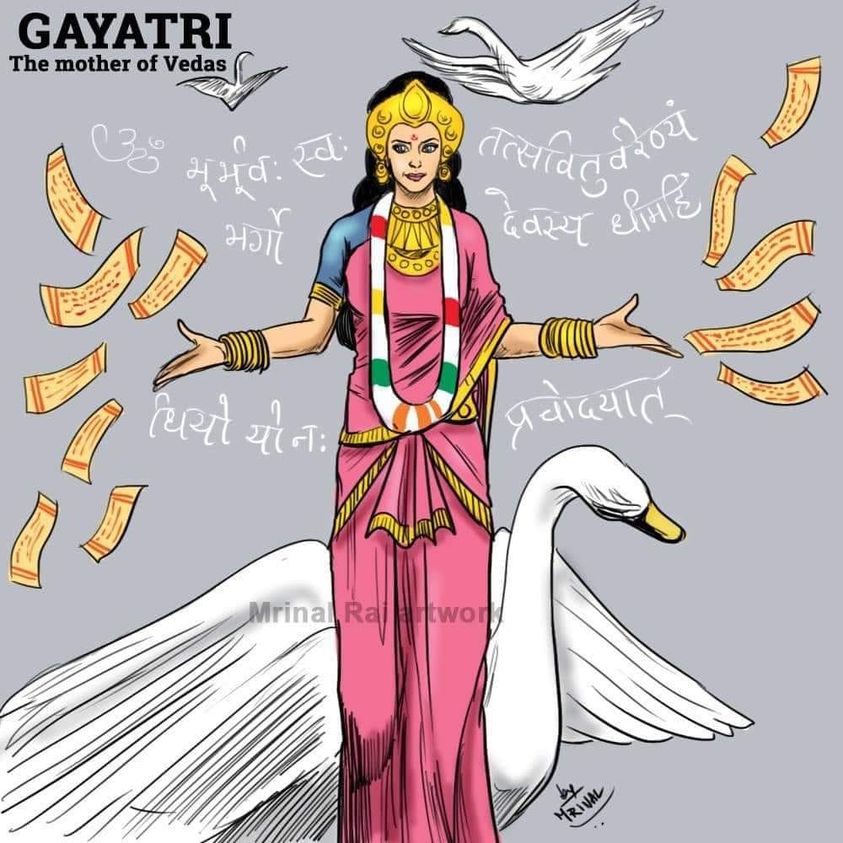
Raksha bandhan songs:
Phulon ka.mpeg
The word ritual is derived from the word ritu which means season in Sanskrit. Rituals reflect the change of seasons and change of times. Accordingly the symbolism and meaning of the rituals also change in their perception by people. The tying of the thread - suraksha kavach, today has acquired the meaning of a brother promising to protect his sister. Feminists wail and complain that this is a patriarchal festival as festival assumes women need protection by their brothers.Let’s examine this claim with some history, some facts and our beliefs behind this celebration.
I. Origins of tying the thread
Devi Shachi, in her role akin to adi shakti , tied the thread to dev Indra , gracing him with her strength, motivating him to fight the asurs who had repeatedly assaulted and defeated him and his devtas. Dev Indra had become despondent and weak and lost his will to fight back. However, after tying of the thread and shielded with powers of Shachi, Indra got motivated and once again fought the asurs and regained his kingdom of heaven.
Draupadi and Krishn
In Mahabharat , Draupadi the wife of the Pandavas had once torn a strip of silk off her sari and tied it around krishna’s wrist to stop the bleeding from a battlefield wound. Krishn was touched by her gesture and declared her to be his sister, even though they were not related by blood. He promised to repay the debt and then spent the next 25 years doing just that. Draupadi, in spite of being married to five great warriors and being a daughter of a powerful monarch, trusted Krishn whole heartedly.
Krishna repaid the debt of this brotherly love during the “cheer-haran” of Draupadi, which occurred in the assembly of king Dhritarashtr when Yudhisthir, in an unethical move, lost her to the Kauravs in gambling. At that time, Krishn indefinitely extended her saree through divine intervention, so it could not be removed, so it could save Draupadi’s honour. This is how he honoured his Rakhi vow to Draupadi.
There are many examples and narratives but in short - over the centuries, this is what Raksha Bandhan meant, the strong offering their protection to the ones who may need it (and not necessarily men protecting women). Nanands tied rakhis to Bhabhis, weaker classes tied rakhi to stronger classes and they still do. However after the 12th century CE, there were repeated Islamic invasions, the brunt of which was felt in northern Bharat, wherein Hindu women were kidnapped, raped, forcibly converted and kept in Islamist harems.
Rani Karnavati
Women, in order to save themselves, sent rakhis to neighbouring kings after their husbands and brothers were killed by the cunning and unethical Islamic invaders. The most well-known tale is that of Rani Karnavati of Chittorgadh who sent a Rakhee to Humayun to protect her from Bahadur Shah of Gujarat. But this was her mistake; the staunch islamist Humayun betrayed her. After this betrayal, she along with hundreds of other kshatriya women committed 'johar' (immolating self in fire); Humayun later saw the power vacuum and used the opportunity to defeat Bahadur Shah and instilled Karnavati's son as puppet King of Mewar. Nevertheless, the practice of tying rakhee to brothers by sisters became prevalent in those areas which were directly under Islamic jihadi threat.
Gurudev Rabindranath Thakur
Hundreds of years later, in 1905, gurudev Rrabindranath Thakur used the original symbolism of Raksha Bandhan to unite Bengalis (irrespective of whether they were Hindus or Muslims). This started the ritual of brothers tying Rakhee to brothers in order to protest against the partition of Bengal. He did succeed to a large extent and the partition was reversed in 1911. But the British had succeeded in alienating the Muslims from Hindus using the supremacist exclusivist ideology of Quran. In 1906, the Indian Muslim league was formed, which ultimately led to the violent and bloody partition of Bharat.
Just like Humayun (and many more after him), the Muslims once again betrayed their Hindu brothers and chose Pakistan over Virat Bharat. Hundreds of Hindu brothers were killed; Hindu sisters were once again kidnapped, raped and forcibly converted (More on these in some other article).
Contemporary Nationalism and Raksha Bandhan
Nationalist groups like RSS, inspired by gurudev, continue this practice of tying rakhee to each other. it is important for a worldwide hindu brotherhood/sisterhood. And thus it's nowhere a patriarchal festival. Women protect men just as men protect women. Given the spirit of this festival, this is also the day when we tie a thread on the hands of our security forces personnel for they're the real protectors of this nation - An apt gesture on an apt day. Ceremonially, school children can be seen tying Raksha thread to our President, Prime minister and other ministers in center and states. All these gestures go about strengthening our bonds in the society and reinforce the value system of mutual trust in our younger generations, streamlining them with high patriotic values.
II. Spiritual view
Words of wisdom (most likely by sri sri Ravi Shankar) by Sanatan philosophy go such: "it is often believed that on this day, the sister ties the sacred thread or band on the brother’s wrist and asks him to protect her at all times. This is what is commonly heard and told, isn’t it? But this is not the only essence or spirit of Raksha Bandhan. The true secret of Raksha Bandhan is that when a sister ties the thread on her brother’s wrist, it is a gesture of saying that “i will protect you at all times”. So it is the sisters who pray and wish for the protection and well-being of their brothers. This is what Raksha Bandhan truly means.
When we celebrate the special and unique tradition of Raksha Bandhan, it is the sister who (takes the vow and) protects her brother. So a few might wonder how a woman who is considered as 'weak and fragile' can protect a man and give him moral strength and support.
Women possess a very unique power within themselves – the Sankalpa-Shakti (the power of will and determination). So a woman too can protect and give support to a man using her strong will power and inner strength. Inner strength always trumps external one as the latter is nothing without the former. A Woman possess the power of feelings and emotions, and has great inner strength within them. So according to some philosophies, on the day of Raksha Bandhan, it is the women who protect the men with their blessings and inner strength (by tying a sacred thread on the wrist of the brother).
We can see that one is free to interpret this festival either ways and any tags of matriarchy or patriarchy are a complete nonsense and reflects an ignorant mind. So as siblings tie up threads of Rakhee on Raksha Bandhan, we celebrate the day as affirmation of our trust and love among our brothers and sisters. The central theme of this festival is mutual respect and a promise of standing by your loved ones while they grace you with their blessings and good wishes.
Raksha Bandhan celebration implies the basic element of an amicable and harmonious social life where all members of the society look upon themselves as brothers and sisters and as children of one common motherland.
At its core, Raksha Bandhan signifies an extraordinary connection between two people, characterized by a promise to respect, love, and uplift one another. Sacred thread is imbibed with mantras shakti.
When friends and neighbors exchange Rakhi, it highlights the need for harmony in the larger community. Rakhi signifies the thread of protection, and it carries a profound message of fostering universal brotherhood and sisterhood. This custom prompts people to see the whole Earth as a single global family, as expressed in the phrase "Vasudhaiva Kutumbakam."
Universal Oneness Day celebration is based on the concept of an amicable and harmonious social life among all society members. This connection between community members is characterized by a promise to respect, love, and uplift one another. It carries a profound message of fostering universal oneness. We are one family on this planet earth and our relations have the foundation of good will, mutual respect, acceptance, tolerance, and forgiveness. This leads to a happier, healthier, and stronger community.
Let’s remove biases and misunderstandings and come together to celebrate Universal Oneness Day.
Raksha of Sanskriti, Prakriti, Sanskar, and Sambandh. Sambandh can be blood relations or soul/love relations. Sambandh should have Souhard सौहार्द (amicable, peaceful, cordial) , Sadbhav, Sahyog/Samadaar समादर , and Shama क्षमा.
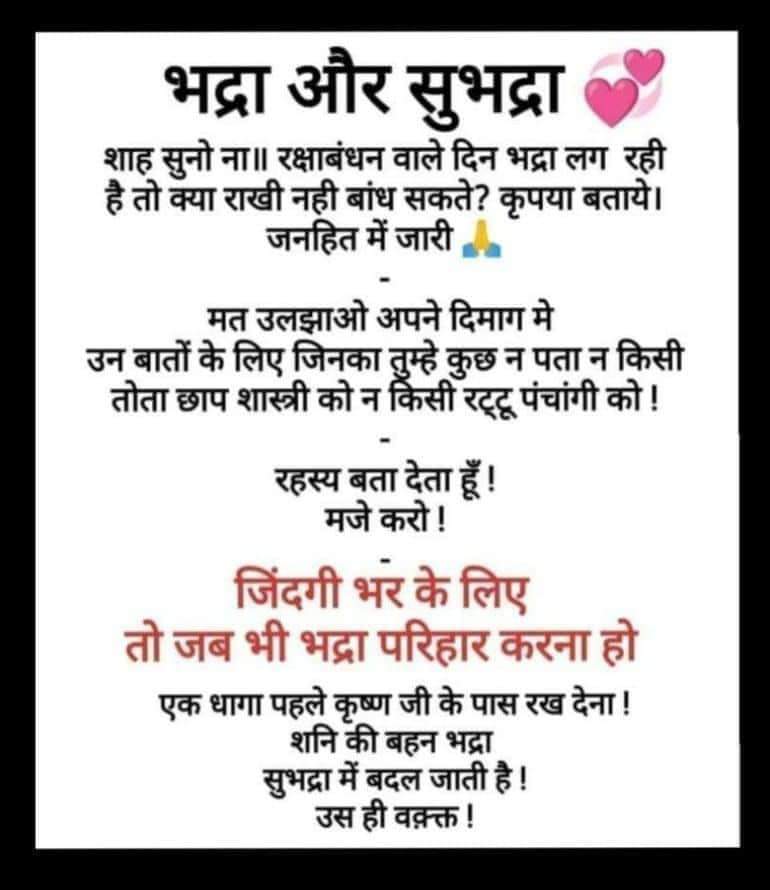
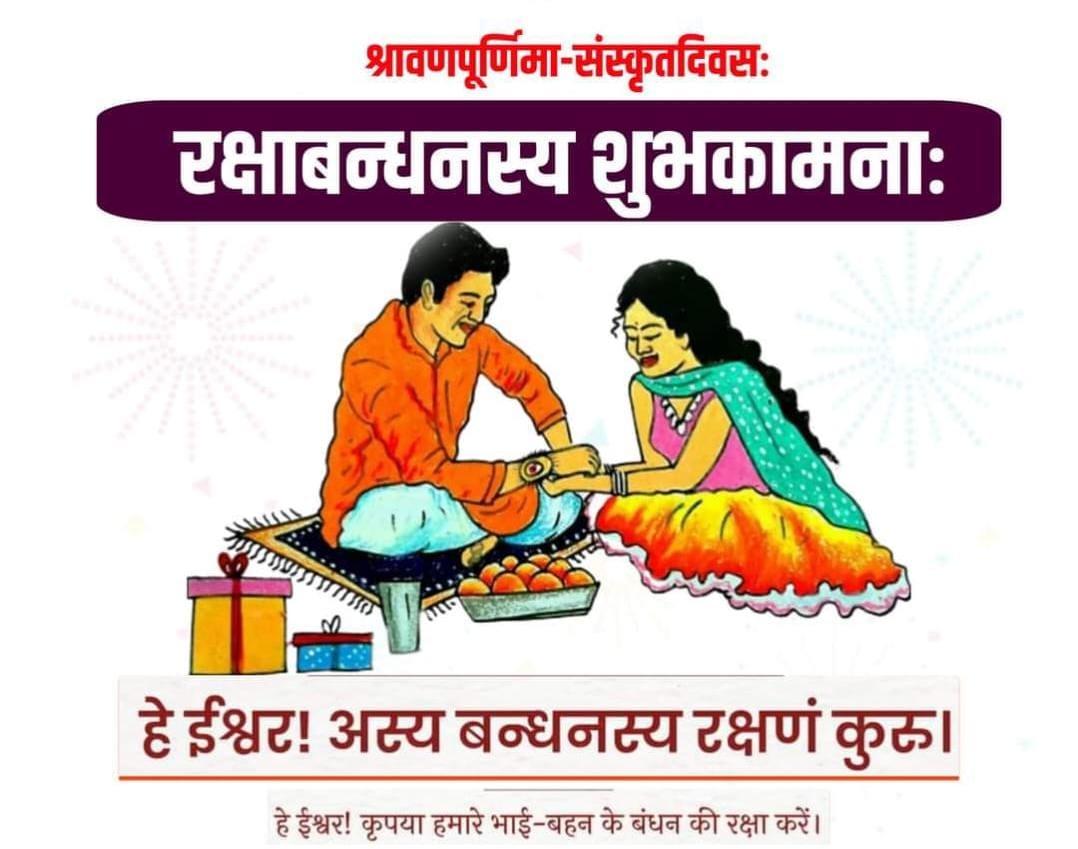
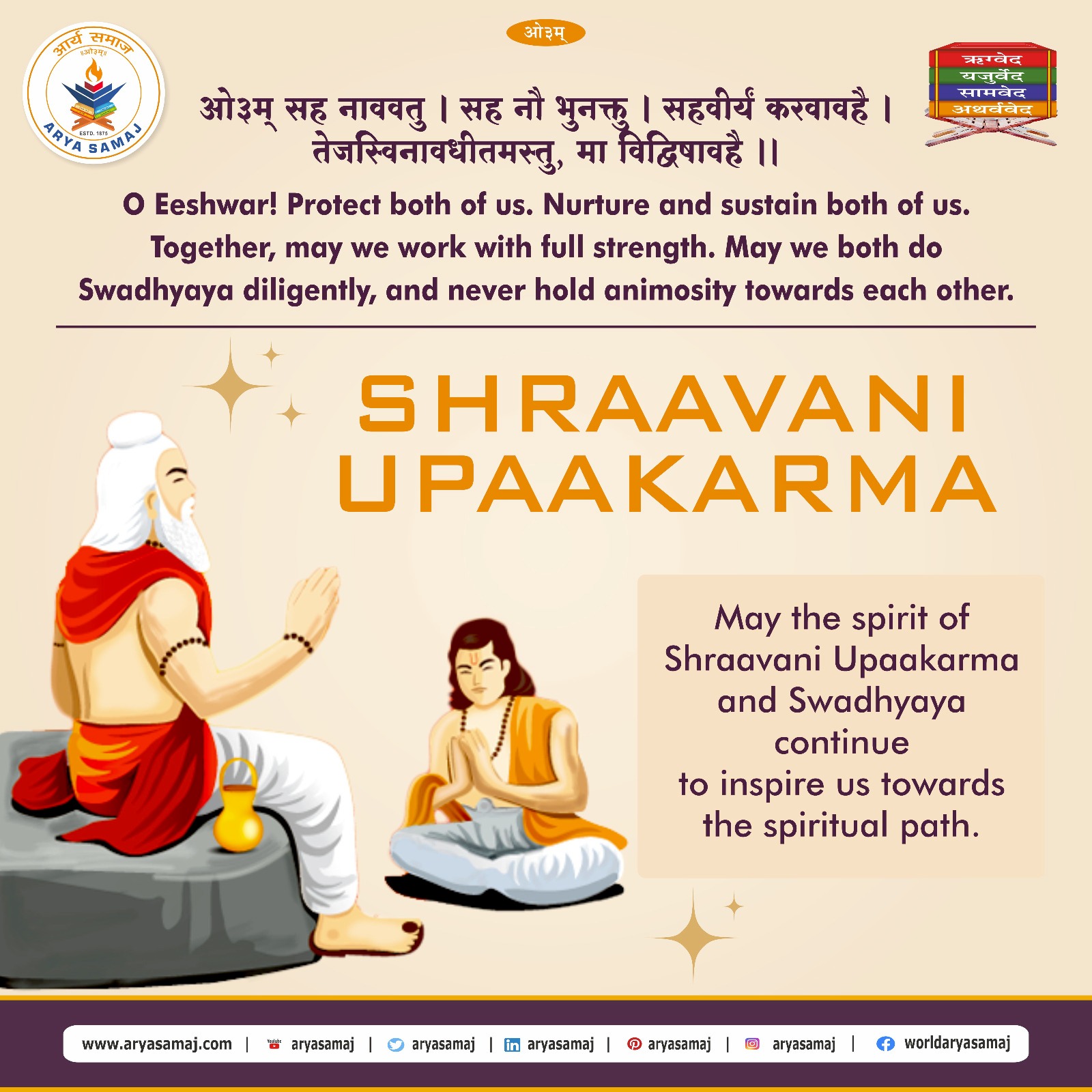
ऐसे रिश्ते वर्तमान में कहां लुप्त हो गए
'वह अनोखा भाई'
महादेवी वर्मा को जब ज्ञानपीठ पुरस्कार से सम्मानित किया गया था, तो एक साक्षात्कार के दौरान उनसे पूछा गया था, 'आप इस एक लाख रुपये का क्या करेंगी? '
कहने लगी, 'न तो मैं अब कोई कीमती साड़ियाँ पहनती हूँ , न कोई सिंगार-पटार कर सकती हूँ।
ये लाख रुपये पहले मिल गए होते तो भाई को चिकित्सा और दवा के अभाव में यूँ न जाने देती.' कहते-कहते उनका दिल भर आया.
कौन था उनका वो 'भाई'?
हिंदी के युग-प्रवर्तक औघड़-फक्कड़-महाकवि पंडित सूर्यकांत त्रिपाठी 'निराला', महादेवी के मुंहबोले भाई थे।
एक बार वे रक्षा-बंधन के दिन सुबह-सुबह जा पहुंचे अपनी लाडली बहन के घर और रिक्शा रुकवा कर चिल्लाकर द्वार से बोले, 'दीदी, जरा बारह रुपये तो लेकर आना।'
महादेवी रुपये तो तत्काल ले आई, पर पूछा, 'यह तो बताओ भैय्या, यह सुबह-सुबह आज बारह रुपये की क्या जरूरत आन पड़ी?
हालाँकि, 'दीदी' जानती थी कि उनका यह दानवीर भाई रोजाना ही किसी न किसी को अपना सर्वस्व दान कर आ जाता है, पर आज तो रक्षा-बंधन है, आज क्यों?
निराला जी सरलता से बोले, "ये दुई रुपया तो इस रिक्शा वाले के लिए और दस रुपये तुम्हें देना है।
आज राखी है ना! तुम्हें भी तो राखी बँधवाई के पैसे देने होंगे।"
ऐसे थे फक्कड़ निराला और ऐसी थी उनकी वह स्नेहमयी 'दीदी'।
गर्व है हमें मातृभाषा को समर्पित ऐसे निराले कवि निराला जी और कवयित्री महादेवी पर। निःस्वार्थ प्रेम
aaj_manaye_raksha_bandhan.mp3
आज मनायें रक्षाबन्धन
अतीत से नव-स्फूर्ति लेकर
वर्तमान में दृढ़ उद्यम कर
भविष्य में दृढ़ निष्ठा रखकर कर्मशील हम रहे निरन्तर ॥१॥
बलिदानों की परम्परा से
स्वराज्य है यह पावन जिनसे
वंदन उनको कृतज्ञता से ध्येय-भाव का करें जागरण ॥२॥
स्वार्थ-द्वेष को आज त्यागकर
अहं-भाव का पाश काटकर
अपना सब व्यक्तित्व भुलाकर विराट का हम करते दर्शन ॥३॥
अरुण-केतु को साक्षी रखकर
निश्चय वाणी आज गरजकर
शुभ-कृति का यह मंगल अवसर निष्ठा मन में रहे चिरंतन ॥४॥